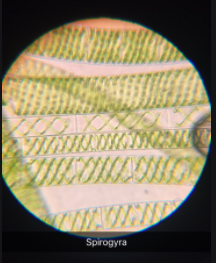
Sketch, label and describe the spirogyra.
Answer
457.2k+ views
Hint: Spirogyra is found in the freshwater. It is the filamentous algae. It has spiral shape and contains chloroplasts. It contains cell wall, plasma membrane, nucleus, chloroplast, pyrenoids and vacuole. They appear as the floating slimy masses and also referred to as scum.
Complete answer:
The free floating green algae in freshwater are called spirogyra. The structure of the spirogyra is filamentous. It contains spiral shaped chloroplasts.
Vegetative body structure of spirogyra is explained below:
(a)External features:
-Spirogyra has an unbranched and filamentous vegetative body structure.
-It has a long, slender and multicellular plant body.
-The filamentous body contains numerous elongated and identical cells which are arranged vertically. -Filament is usually surrounded by a membrane of mucilage
-Protoplasm: Following parts are present in protoplasm:
-Plasma membrane: It is situated just below the cell wall. It covers the inner matters of the protoplasm.
(b)Internal Features: Cytoplasm is situated inside the cell wall which is a jelly like substance and present very close to the plasma membrane.
-Cell vacuole: Each cell has a large vacuole placed at the centre.
-Nucleus: Each all contains a single nucleus. It remains suspended within the cytoplasm with the help of some cytoplasm strains.
The silvery granules present in each chloroplast are called pyrenoids.
-Chloroplast: Chloroplasts of this all are long and flattened as tape. They appear in spiral shape around the saciole. Usually the number of chloroplasts may vary from one to seven.

Note: The holdfast or hapteta are present at the posterior end of the filament these are the unicellular compressed part by which the plant body remains attached with any substratum. A plenty of protein piles up in the pyrenoids are present in spirogyra. Starch is deposited as recent food around the pyrenoids. Spirogyra makes their own food as they contain chloroplast. It is also called water silk, mermaid’s tresses, or pond scum.
Complete answer:
The free floating green algae in freshwater are called spirogyra. The structure of the spirogyra is filamentous. It contains spiral shaped chloroplasts.
Vegetative body structure of spirogyra is explained below:
(a)External features:
-Spirogyra has an unbranched and filamentous vegetative body structure.
-It has a long, slender and multicellular plant body.
-The filamentous body contains numerous elongated and identical cells which are arranged vertically. -Filament is usually surrounded by a membrane of mucilage
-Protoplasm: Following parts are present in protoplasm:
-Plasma membrane: It is situated just below the cell wall. It covers the inner matters of the protoplasm.
(b)Internal Features: Cytoplasm is situated inside the cell wall which is a jelly like substance and present very close to the plasma membrane.
-Cell vacuole: Each cell has a large vacuole placed at the centre.
-Nucleus: Each all contains a single nucleus. It remains suspended within the cytoplasm with the help of some cytoplasm strains.
The silvery granules present in each chloroplast are called pyrenoids.
-Chloroplast: Chloroplasts of this all are long and flattened as tape. They appear in spiral shape around the saciole. Usually the number of chloroplasts may vary from one to seven.

Note: The holdfast or hapteta are present at the posterior end of the filament these are the unicellular compressed part by which the plant body remains attached with any substratum. A plenty of protein piles up in the pyrenoids are present in spirogyra. Starch is deposited as recent food around the pyrenoids. Spirogyra makes their own food as they contain chloroplast. It is also called water silk, mermaid’s tresses, or pond scum.
Recently Updated Pages
Can anyone list 10 advantages and disadvantages of friction

What are the Components of Financial System?

How do you arrange NH4 + BF3 H2O C2H2 in increasing class 11 chemistry CBSE

Is H mCT and q mCT the same thing If so which is more class 11 chemistry CBSE

What are the possible quantum number for the last outermost class 11 chemistry CBSE

Is C2 paramagnetic or diamagnetic class 11 chemistry CBSE

Trending doubts
Which is not a source of freshwater 1 Glaciers and class 11 chemistry CBSE

10 examples of friction in our daily life

The correct order of melting point of 14th group elements class 11 chemistry CBSE

Difference Between Prokaryotic Cells and Eukaryotic Cells

One Metric ton is equal to kg A 10000 B 1000 C 100 class 11 physics CBSE

What is the specific heat capacity of ice water and class 11 physics CBSE




